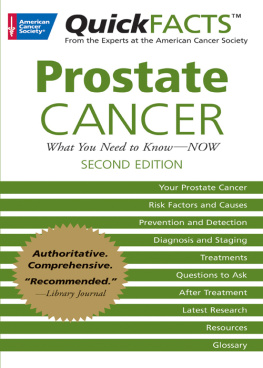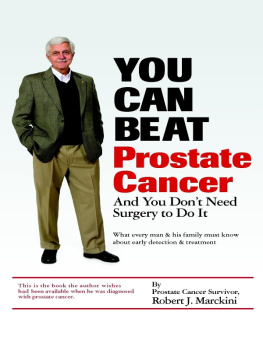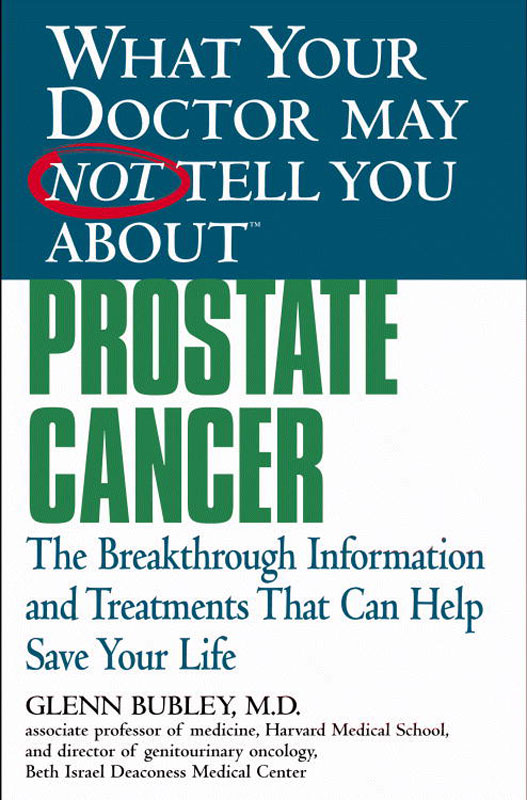This book is not intended as a substitute for medical advice of physicians. The reader should regularly consult a physician in all matters relating to his or her health, and particularly in respect of any symptoms that may require diagnosis or medical attention.
Copyright 2005 by Glenn Bubley, M.D. and Lynn Sonberg
All rights reserved.
Warner Books
Hachette Book Group, USA
237 Park Avenue, New York, NY 10017
Visit our Web site at www.HachetteBookGroupUSA.com.
First eBook Edition: January 2005
ISBN: 978-0-446-53668-4
Cover design by Diane Luger
ACCLAIM FOR
WHAT YOUR DOCTOR MAY NOT
TELL YOU ABOUT(TM)PROSTATE CANCER
The complexity of prostate cancer and treatment options can be overwhelming for patients. Dr. Bubleys well-written, concise, and contemporary book will be a great companion for patients and their families for making some of the difficult decisions that need to be made.
Philip Kantoff, M.D., chief, Division of Solid Tumor Oncology, Dana Farber Cancer Institute, and professor of medicine, Harvard Medical School
This is one of the best books for men with prostate cancer. The basics of diagnosis and treatment are all presented in a very clear, easy-to-understand way. It has the best discussion anywhere of clinical trials and how you might benefit from them.
Charles E. Myers, M.D., director, American Institute for Diseases of the Prostate
An important and unique resource for patients and their families who are facing the personal battle against prostate cancer... With remarkable clarity, this book highlights the relevant issues and provides an understandable, succinct, yet comprehensive guide for a practical manner whereby patients and their families can approach the broad range of treatment options.
Martin G. Sanda, M.D., visiting associate professor of urology, Harvard Medical School
The author (GJB) wishes to dedicate this book to
his patients with prostate cancer for all they have
taught him. He also wishes to thank his family,
Lynn, Matt, and Janna for their support,
encouragement and sense of humor.
F or me, fighting prostate cancer is personal. I have not been diagnosed with the disease, and neither has anyone in my immediate family, but I have spent almost every day for the past twenty-five years thinking about prostate cancer and what can be done to prevent or treat it. I have dedicated my professional life to treating men with advanced prostate cancer, men for whom conventional treatments have failed and hope for a cure has started to dwindle.
Over the years, I have seen too many good men die from this disease. I have also seen a growth in the number of men who add years to their lives through the use of new treatments and experimental therapies. By the time I retire, I fully expect that prostate cancer will have become a much more manageable disease, one that can be controlled with regular medication. Some men with the most aggressive forms of the disease may never be cured and declared cancer-free, but they may be able to use a number of treatments either currently available or in development to keep the cancer from spreading. In essence, prostate cancer will be stalemated; it will continue to linger in the body, but it will be much less likely to have the power to kill.
This vision of manageable prostate cancer will soon become a reality. Researchers already have quite a few treatments in development that may prove useful, at least for a time. When one therapy fails, doctors have others to try. This approach to disease management requires that both doctors and their patients remain on top of the research about appropriate and effective treatments. This can be a daunting and overwhelming task, but this book can help you make sense of the dizzying array of treatment choices so that you can find the approach that is right for you or the person you love. It will also explain benign prostate problems, which afflict many men as they grow older.
PROSTATE CANCER: EVERY MANS DISEASE
A decade ago, most men dismissed prostate cancer as a disease of older men, those in their seventies and beyond. Too often it was not diagnosed until after the cancer had spread to the bones or other organs. Today, prostate cancer is recognized as every mans disease. Due to increased public awareness and improved screening tests, the disease is detected much more often in men in their forties and fifties; and, more important, it is much more often identified at the earliest and most treatable stages.
Consider the grim statistical reality: In the United States, men have an alarmingly high one-in-six lifetime risk of developing prostate cancer, making the disease the most common type of cancer among American men and the second leading cause of cancer death. Each year, about 180,000 American men are diagnosed with prostate cancer, and nearly 32,000 die from the disease. In other words, every three minutes a man is diagnosed with prostate cancer, and every sixteen minutes another man dies from the disease.
What Causes Prostate Cancer?
Prostate cancer is a complex disease with a number of contributing factors. A diet high in fat and low in fruits and vegetables may play a role in causing prostate cancer. (The role of diet is discussed in detail in chapter 10.) High levels of the hormone testosterone may also play a role in younger men; testosterone both stimulates the growth of prostate tissue and jump-starts the growth of cancer cells once the cancer takes hold.
There is a definite familial or genetic component to prostate cancer risk in men of all races. If a close relative (brother or father) has cancer at a young age (under sixty), the genetic link appears stronger than if the same relative develops cancer at age eighty-five. For more information on genetic links, see chapter 11, Brothers and Sons.
Prostate cancer deserves your respect, but for most men the diagnosis is not a death sentence. With proper treatment, prostate cancer can be controlled. Many men have an indolent or less aggressive form of the disease. More than half of newly diagnosed patients respond well to traditional treatments and remain free of prostate cancer for the rest of their lives. Those men whose cancer recurs must face a second round of treatment, but a majority of them respond to follow-up care. And even those men with aggressive cancers that return time and again can make use of a number of new and effective treatments.
We live an era of new hope, and this book can help you take advantage of all the therapies currently available. I support a truly integrative approach to treating prostate cancer, one that takes an impartial and balanced look at the best of both mainstream and experimental treatments. My goal in this book is to provide you with a clear and decisive guide to living with prostate cancer as well as information that will transform more advanced prostate cancer from a fatal condition to a treatable one. Remember also that many people are now engaged in trying to make headway in this disease. The future looks bright, so be on the lookout for newer innovations.
NO CLEAR ANSWERS
Prostate cancer can be a confusing cancer to treat. Unlike other tumors, prostate cancer may respond well to several different approaches. As a result, there is no clear answer to the question: Which treatment is best for me? For many of the different stages of prostate cancer, especially low-grade cancer that has not spread beyond the prostate, doctors do not agree on a single approach to treatment; in other words, there is no uniform standard of care. In these cases, it is up to the patient to work with his doctor to weigh the advantages and disadvantages of each treatment. In later chapters, I will review the preferred standard of care, when it exists, and explain the factors that should be taken into consideration when comparing various approaches to treatment.












